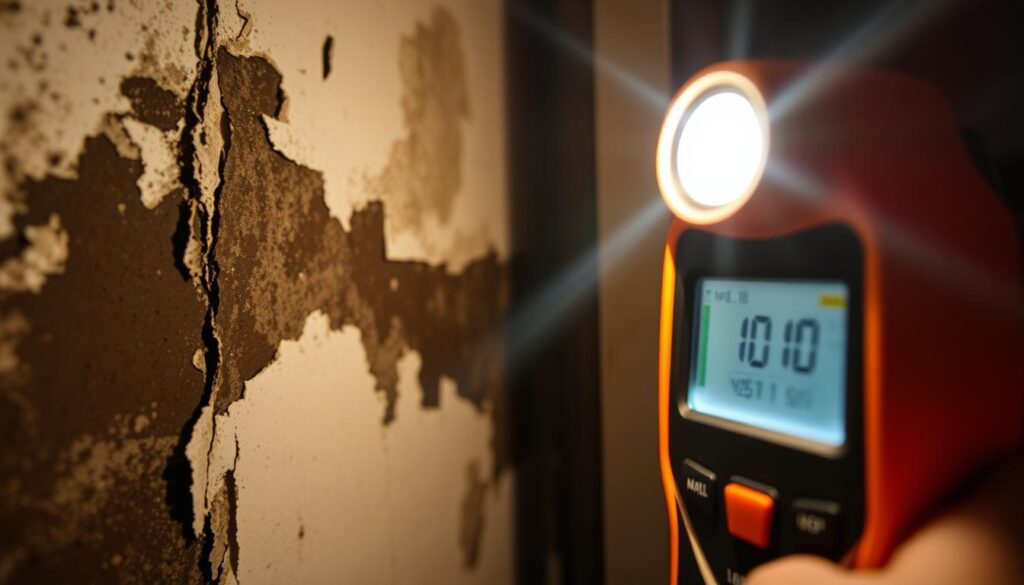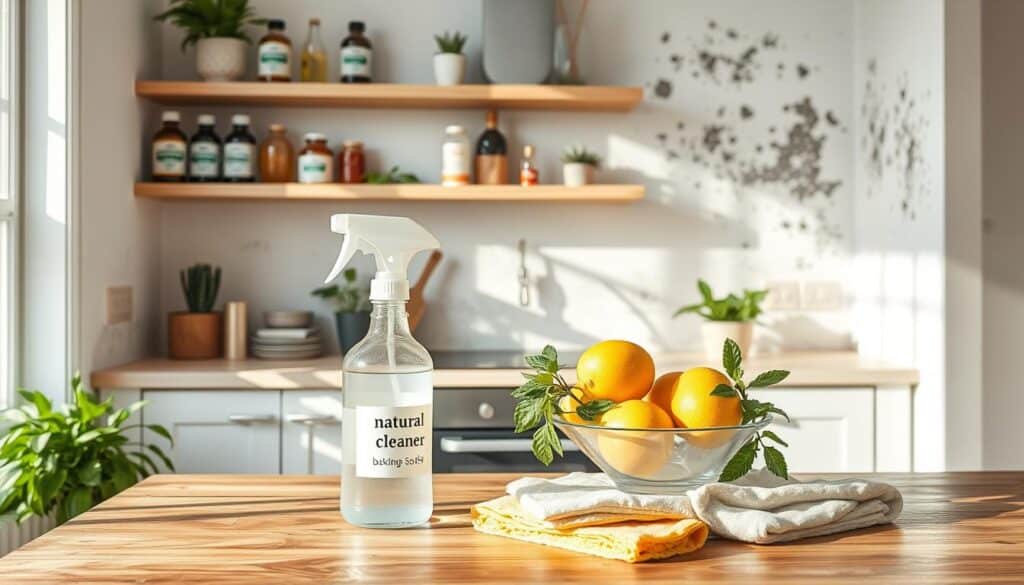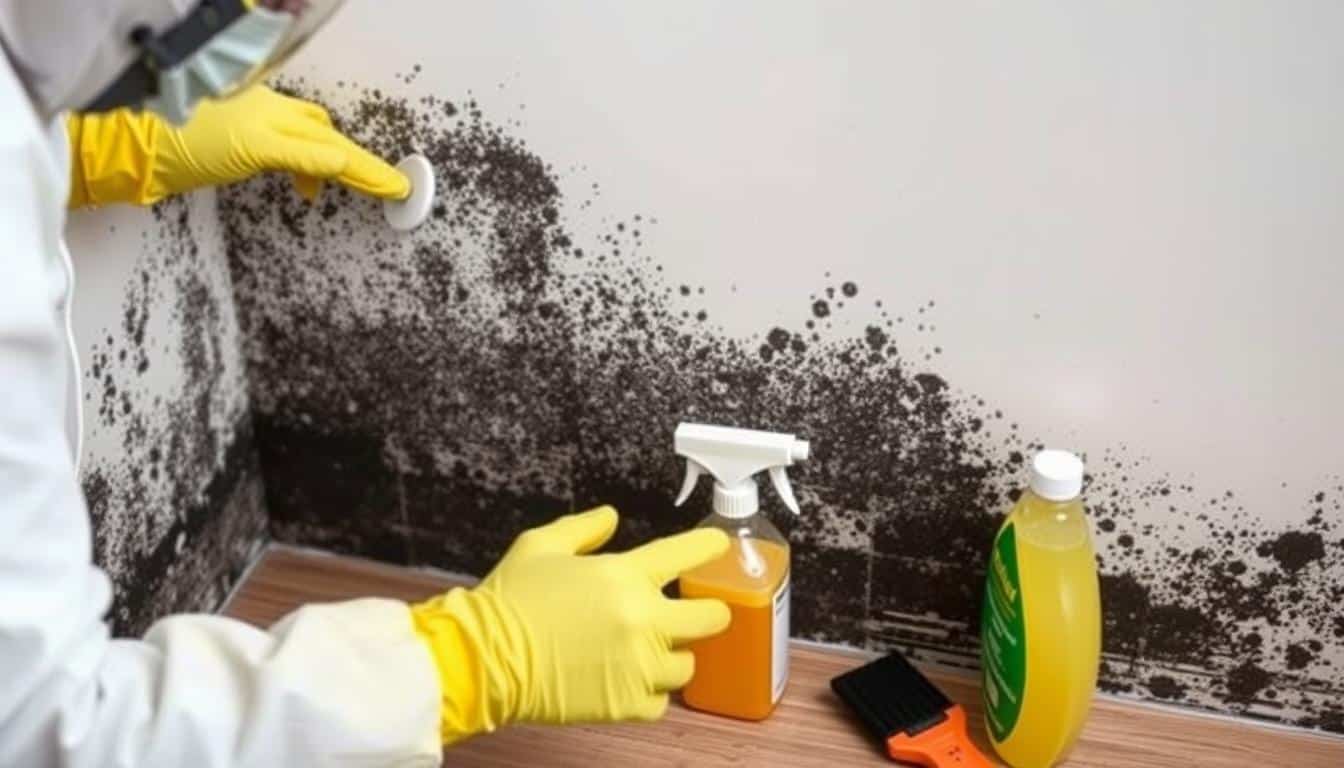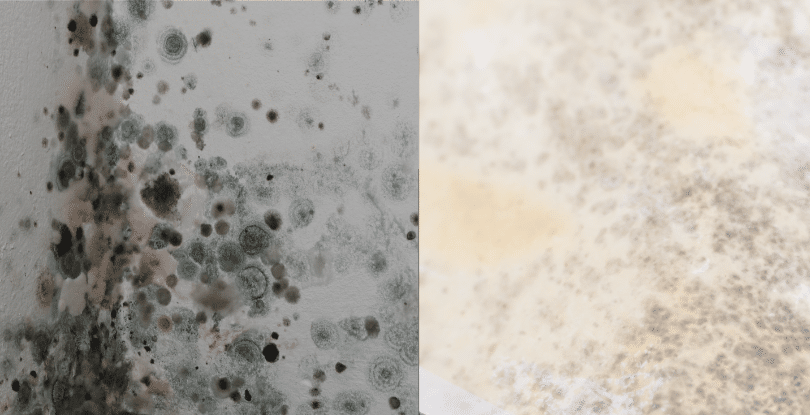Did you know black mold can grow fast, especially in humid places like bathrooms and basements? This fact shows how important it is to deal with black mold quickly. As a homeowner, I’ve found that fast action is key to keep our air clean and our health safe.
Black mold is dark gray or black and loves moist places. It smells musty and can harm our breathing. So, finding and fixing the moisture problem is the first step in removing mold.
I’ve seen black mold grow in basements, bathrooms, and where there’s water leaks. Knowing where mold likes to grow helps us stop it and keep our homes healthy.
Key Takeaways
- Black mold grows rapidly in high-humidity areas
- Early identification and removal are crucial for health
- Common growth areas include basements and bathrooms
- Address moisture sources before starting removal
- Proper protective gear is essential for safe removal
- Both natural and chemical solutions can be effective
- Professional help may be needed for large infestations
Understanding Black Mold: What It Is and Why It’s Dangerous
Black mold is a fungus that grows in damp places. It’s not more dangerous than other molds, but it can be harmful. Especially for people with allergies or weak immune systems. As a homeowner, I’ve learned it’s key to spot and deal with black mold to keep indoor air quality good.
Identifying Black Mold in Your Home
Black mold shows up as dark spots on walls and ceilings. It smells musty because of certain compounds. To be sure, getting a professional mold check is best. Mold testing kits can be used, but they might not give accurate results, which can slow down removal.
Health Risks Associated with Black Mold Exposure
Being around black mold can cause health problems. Symptoms include:
- Respiratory issues
- Allergic reactions
- Headaches
- Skin irritation
- Fatigue
Long-term exposure to toxic mold can lead to serious health issues. It’s worth noting that while black mold isn’t more dangerous, some types can produce toxins. These toxins can cause more severe health problems.
Common Areas Where Black Mold Thrives
Black mold likes humid, poorly ventilated areas. It’s often found in:
- Bathrooms
- Basements
- Attics
- Around windows
- Under sinks
To stop black mold, control moisture and ensure good air flow. Regular mold checks help find and fix problems early. This keeps your home healthy for you and your family.
Locating the Source of Moisture: The First Step in Black Mold Removal

Finding the source of moisture is key to removing black mold. Black mold loves dark, damp places like basements and under sinks. I start by inspecting these areas carefully.
Next, I use a moisture meter to check for moisture. If the reading is over 17%, it means there’s mold or water damage. This tool helps me find hidden water damage.
Common causes of too much moisture include:
- Leaky pipes
- Faulty faucets
- Malfunctioning water heaters
- Areas with poor ventilation
Fixing these problems stops mold from coming back. It’s not just about cleaning up mold. It’s about solving the real problem for good.
“Identifying and fixing moisture sources is the foundation of effective mold remediation.”
Dealing with black mold is more than making your home look better. It’s about keeping you healthy. Black mold can make you sick, causing symptoms like sneezing and headaches. That’s why I always check for moisture and mold first.
Essential Safety Precautions Before Tackling Black Mold
When dealing with mold, safety is my number one concern. I’ve found that getting ready and wearing the right gear are key for safe mold removal. Let’s explore the important steps and tools needed before starting this tough job.
Protective Gear You’ll Need
When facing black mold, safety gear is a must. I always wear a respirator to avoid breathing in harmful spores. Safety goggles protect my eyes from irritants. Rubber gloves and protective clothing keep my skin safe from mold.
Remember, mold can spread through cuts, so covering up is crucial.
Preparing the Area for Mold Removal
Before starting, I turn off the HVAC system to stop spore spread. I seal doorways with plastic sheeting to keep the mold in. For big areas, I might call in the pros. The EPA says experts are best for big jobs to clean up safely.
Proper Ventilation Techniques
Good air flow is key during mold removal. I use exhaust fans to blow air outside and cut down spore levels. For bigger areas, I use negative air pressure machines to keep spores from spreading.
| Contamination Size | Recommended Action |
|---|---|
| Less than 10 sq ft | DIY with proper safety gear |
| 10-30 sq ft | Limited containment, specific cleaning practices |
| 30-100 sq ft | Full containment, extensive cleaning |
| Over 100 sq ft | Professional remediation recommended |
By taking these safety steps and using the right gear, I can safely remove black mold. Remember, controlling moisture is key to stopping mold from coming back. Fixing the water problem is as important as cleaning up the mold.
DIY Black Mold Removal: Natural Solutions
I’ve discovered that natural mold removal methods are both effective and good for the planet. For small mold issues on non-porous surfaces, these natural solutions are amazing. Let’s look at some simple, safe ways to clean mold at home.

White distilled vinegar is a top pick for me. It kills 82% of mold species with its mild acidity. I apply it undiluted to the mold or mix it in a spray bottle. For tough mold, I make a strong paste with baking soda and vinegar.
Here are more natural solutions that work well:
- Tea tree oil: Mix 1 teaspoon with 1 cup of water
- Grapefruit seed extract: 10 drops per cup of water
- Hydrogen peroxide: Dilute 3% solution with water (1:2 ratio)
- Lemon juice: Use juice from 3-5 lemons directly on mold
When using these eco-friendly cleaning methods, I always wear protective gear and ensure proper ventilation. It’s important to remember that if the mold is over 10 square feet or seems toxic, get professional help.
“Natural mold removal solutions can be highly effective for small-scale problems, but always prioritize safety and know when to seek expert assistance.
By using these natural mold removal techniques, I’ve found it easier to keep my home mold-free. Plus, it’s better for the environment.
Chemical-Based Solutions for Stubborn Black Mold
Dealing with black mold can be tough. Chemical mold removal is a strong option. Store-bought mold removers are effective against stubborn mold. They help you take back your space.
Store-Bought Mold Removers
Many commercial products are great at killing mold. For example, RMR-141 is 99.9% effective against mold and other germs. It kills mold and stops it from coming back.
Bleach-Based Solutions: Pros and Cons
Bleach is often used to clean mold. It works well on hard surfaces but can harm some materials. Mix 1 cup of bleach with 1 gallon of water. Always test it first and never mix it with other chemicals.
Hydrogen Peroxide as an Alternative
Hydrogen peroxide is a milder option. A 3% solution can kill mold without the damage bleach causes. It’s safer for many surfaces and doesn’t leave harmful residue.
| Solution | Effectiveness | Safety |
|---|---|---|
| Store-Bought Removers | High | Moderate |
| Bleach Solution | High on non-porous surfaces | Low |
| Hydrogen Peroxide | Moderate to High | High |
When fighting mold, safety is key. Always wear protective gear and ensure good air flow. For big mold problems, get help from mold experts.
Professional Black Mold Removal: When to Call the Experts
Mold can grow quickly, especially after water damage. It can start forming in just 24 hours. That’s why acting fast is key. If mold covers more than 10 square feet or keeps coming back, it’s time to call the pros.
Mold remediation services are essential for big problems. If you see greenish-black slimy mold or suspect toxic mold, don’t hesitate. Professional mold abatement is your safest choice.
Experts use special tools like HEPA air scrubbers and vacuums. They’re ready to tackle hidden mold in damp spots. While DIY works for small areas, pros are needed for bigger jobs.
The cost of professional mold removal can be high, often over $1000. It depends on the job size. Always get quotes from different companies to avoid being overcharged. Experience matters. Companies with over 10 years in mold remediation are usually more reliable.
| Aspect | Professional Mold Removal | DIY Mold Removal |
|---|---|---|
| Suitable for | Areas > 10 sq ft, recurring mold | Minor issues |
| Equipment | Specialized (HEPA air scrubbers, vacuums) | Basic cleaning tools |
| Duration | 1-3 days | Varies |
| Cost | Often > $1000 | Cost of cleaning supplies |
Professional mold remediation usually takes 1-3 days. It’s a small price for long-term peace of mind. If you’re unsure, it’s best to talk to a mold removal expert. They can assess the situation and offer the best solution.
Post-Removal Cleanup and Disposal Techniques
After removing black mold, the work is far from over. It’s vital to clean up properly for a healthy home. Let’s explore the steps I take for complete contamination control.
Safely Disposing of Contaminated Materials
I seal moldy items in plastic bags before throwing them away. This stops spores from spreading. For big items, I use strong garbage bags. Always check local rules for the right way to dispose of them.
Thorough Cleaning of the Affected Area
After getting rid of contaminated items, I clean the area with soap and water. Then, I use a disinfectant to kill any spores left. For surfaces like concrete, I vacuum with a HEPA vacuum to get rid of any leftover particles.
Air Purification Methods
To complete the job, I focus on cleaning the air. HEPA air filters are excellent at catching airborne spores. I also use fans and dehumidifiers to dry the area completely. This step is crucial to stop mold from coming back.
| Cleanup Step | Method | Purpose |
|---|---|---|
| Disposal | Sealed plastic bags | Prevent spore spread |
| Surface Cleaning | Detergent, disinfectant | Remove and kill mold |
| Air Purification | HEPA filters, fans | Eliminate airborne spores |
Remember, drying the area completely is key. I always check that the area is dry before putting back any items. This detailed method ensures effective mold cleanup and keeps contamination under control.
Preventing Future Black Mold Growth
I’ve fought black mold and now I’m focused on keeping it away. The first step is controlling moisture. I use dehumidifiers and ensure good air flow to keep humidity under 50%. This is crucial for the air we breathe indoors.
In my bathroom, I’ve set up an exhaust fan and open windows after showers. I also use a squeegee on shower walls and fix leaks quickly. These habits help prevent mold on tiles and curtains. For damp areas, I apply mold-resistant products and clean often.
I regularly check my home for mold signs like musty smells or water damage. If I find a big area of mold, I call experts. They have the right tools to handle large problems and find hidden moisture. By following these steps, I keep my home mold-free and the air clean.
FAQ
What is black mold, and why is it dangerous?
Black mold is a fungus that can harm your health. It looks dark and smells musty. It can cause breathing problems, allergies, and even pneumonia in some people. It’s important to remove it safely because it’s so dangerous.
Where does black mold commonly grow in homes?
Black mold often grows in bathrooms, basements, and attics. It likes moist places. So, finding and fixing the source of moisture is key.
How do I locate the source of moisture before removing black mold?
Finding the moisture source is the first step in removing black mold. Look for leaks in pipes, faucets, and water heaters. Use a moisture meter to check. Fixing the moisture problem is crucial to stop mold from coming back.
What safety precautions should I take when removing black mold?
Safety is very important when removing black mold. Wear a respirator, goggles, gloves, and protective clothes. Turn off HVAC systems and seal doors. Use fans to keep air moving. Throw away any moldy items in sealed bags.
Can I use natural solutions to remove black mold?
Yes, you can use natural solutions like baking soda, vinegar, and hydrogen peroxide. They work well for small mold problems on non-porous surfaces. Mix baking soda and vinegar in a spray bottle, apply, wait 30 minutes, then scrub and rinse.
What chemical-based solutions are effective for stubborn black mold?
For tough mold, chemical solutions can work. Store-bought removers have strong chemicals. Bleach is good for non-porous surfaces but can harm some materials. Hydrogen peroxide is safer. Always test on a small area first and never mix chemicals.
When should I call a professional for black mold removal?
Call a pro for mold over 10 square feet or in HVAC systems. Experts use special tools and know-how to safely remove mold. They can find hidden mold and fix moisture issues. Costs range from $1,000 to $3,400, depending on the problem.
How do I properly clean up after black mold removal?
After removing mold, clean up is important. Throw away moldy items in sealed bags. Clean with detergent and water, then disinfect. Use HEPA vacuums to get rid of spores. Use air filters or ozone generators to clean the air. Make sure the area is dry before putting back materials.
How can I prevent future black mold growth?
To stop mold, control moisture in your home. Keep humidity below 60%, fix leaks fast, and ensure good ventilation. Use dehumidifiers in damp spots. Regularly check and clean moist areas. Use mold-resistant products and fix water damage quickly to prevent mold.
,000 to ,400, depending on the problem.
How do I properly clean up after black mold removal?
After removing mold, clean up is important. Throw away moldy items in sealed bags. Clean with detergent and water, then disinfect. Use HEPA vacuums to get rid of spores. Use air filters or ozone generators to clean the air. Make sure the area is dry before putting back materials.
How can I prevent future black mold growth?
To stop mold, control moisture in your home. Keep humidity below 60%, fix leaks fast, and ensure good ventilation. Use dehumidifiers in damp spots. Regularly check and clean moist areas. Use mold-resistant products and fix water damage quickly to prevent mold.




